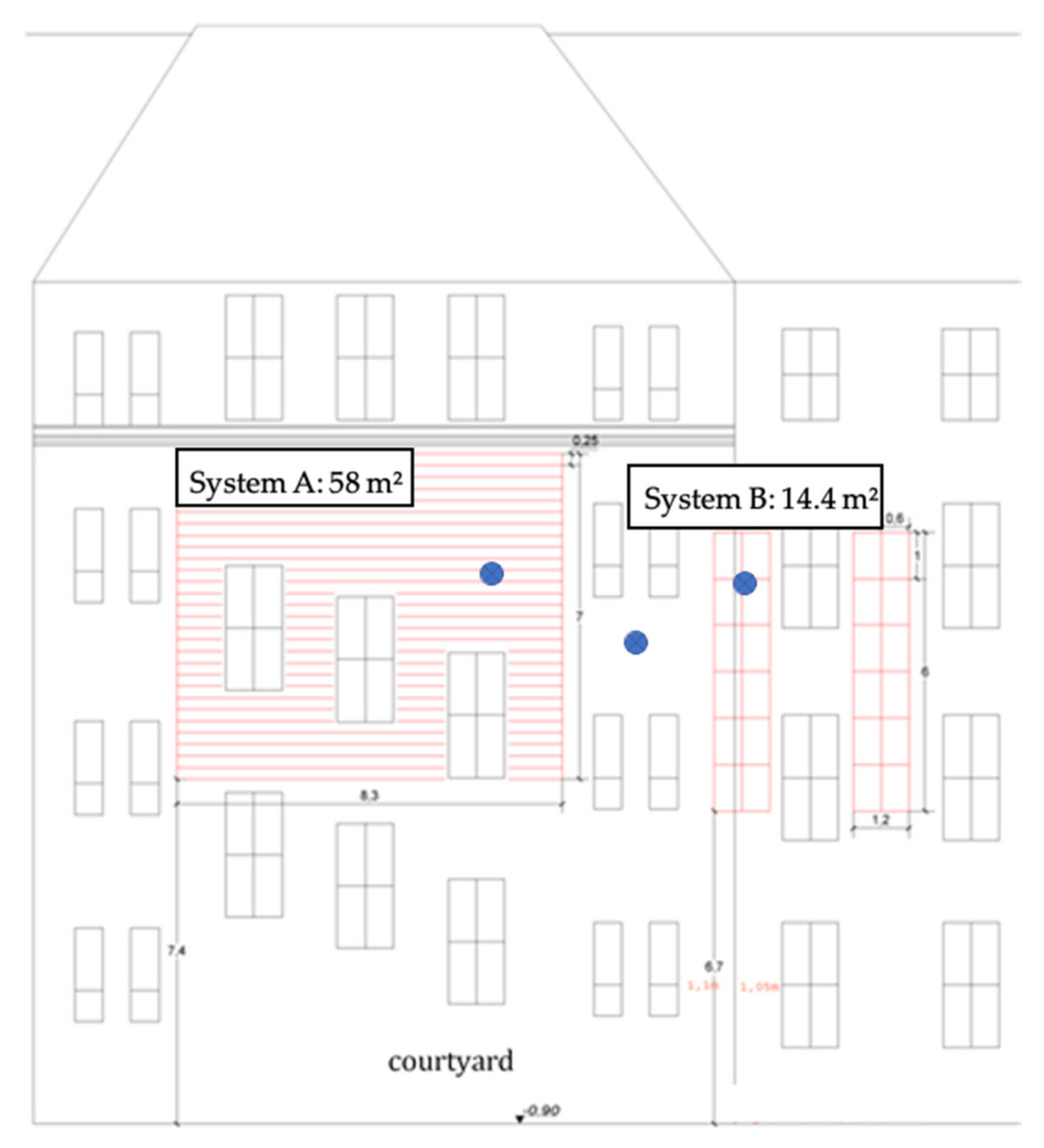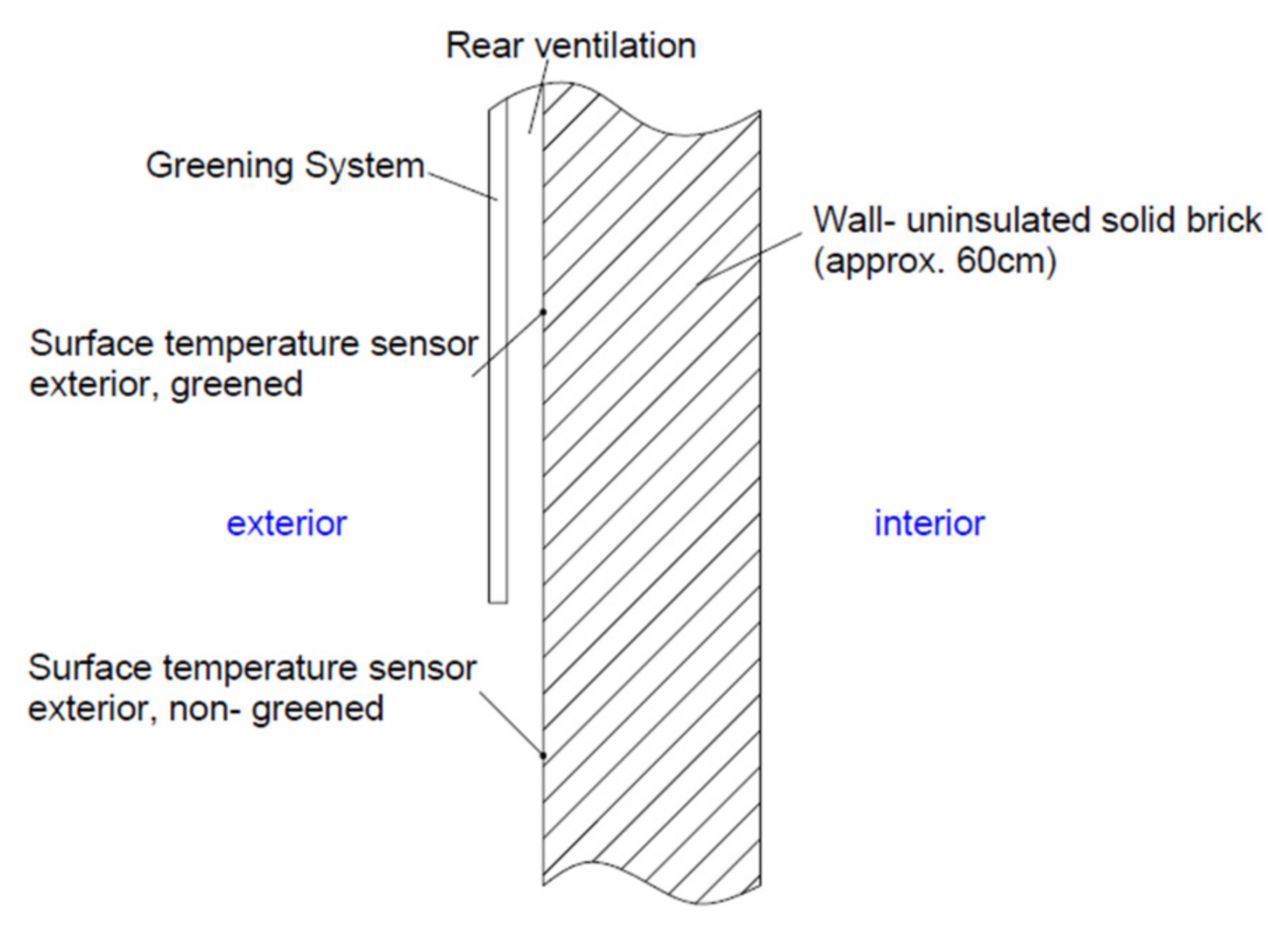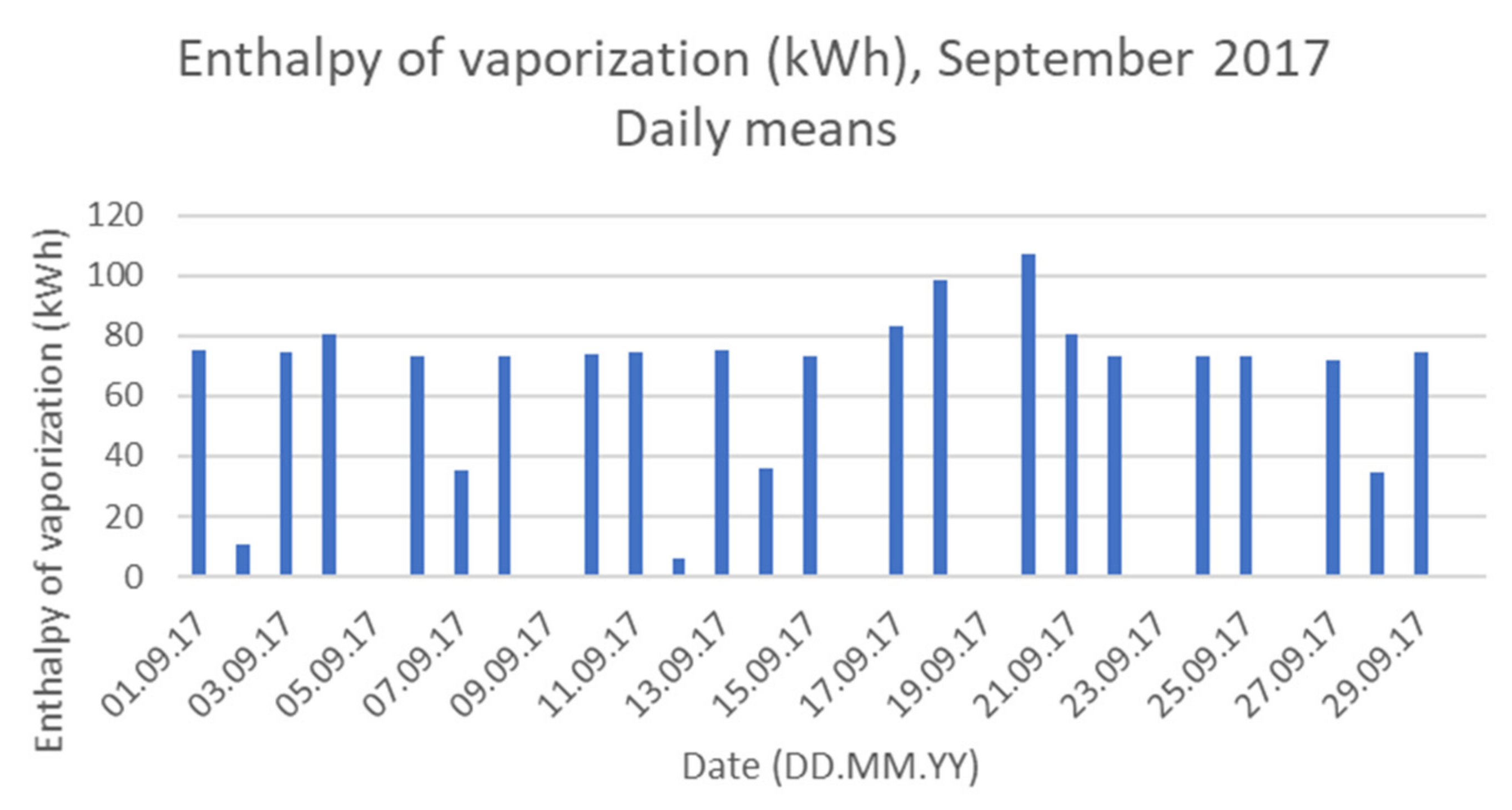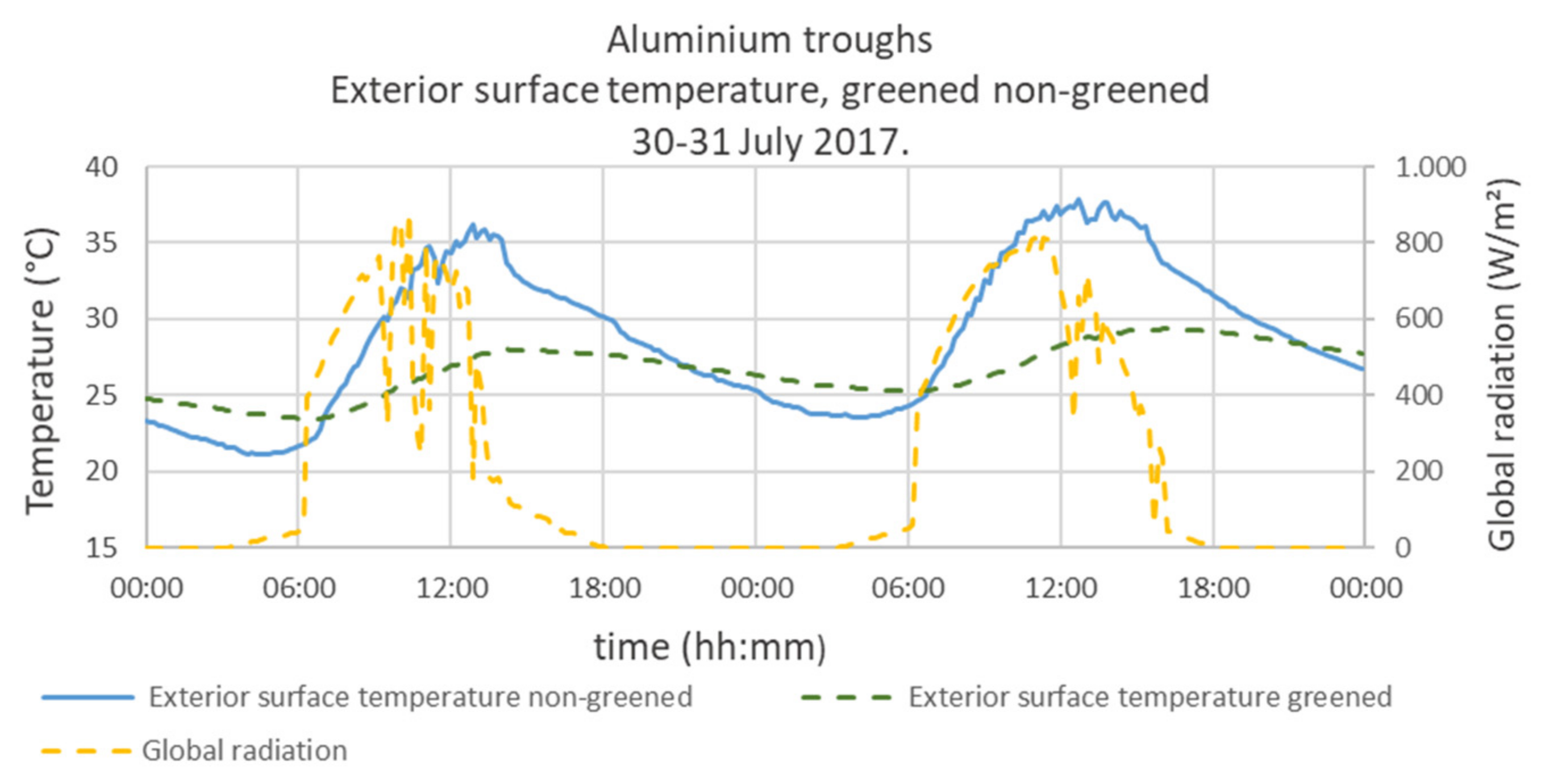Thermal Effects of Vertical Greening in Summer: An Investigation on Evapotranspiration and Shading of Façade Greening in Vienna
Abstract
1. Introduction
2. Materials and Methods
2.1. Studied Greening Systems
- (a)
- System A: Façade greening based on aluminum troughs:
- (b)
- System B: Façade greening system based on cassette system:
2.2. Measurement Methodology
2.2.1. Evaporation Balance
2.2.2. Comparison of Surface Temperatures of Greened and Non-Greened Wall
3. Results
3.1. Evaporation Balance
3.2. Comparison of Surface Temperatures of Greened and Non-Greened Walls
4. Discussion
5. Conclusions
Author Contributions
Funding
Acknowledgments
Conflicts of Interest
Appendix A
| Greening System | Plant Species |
|---|---|
| Aluminum troughs | Achillea millefolium (yarrow), Allium schoenoprasum (chives), Antirrhinum majus (snapdragon), Anthemis tinctoria (camomile), Bergenia cordifolia (bergenia), Calamintha nepeta ‘Triumphator’ (Mountain Mint), Cymbalaria muralis (Cymbalwort), Eruca sativa (Rocket), Geranium cantabrigiense ‘Biokova’ (Cambridge Cranesbill), Geranium makrorrhizum (Balkan Cranesbill), Lysimachia nummularia (Pennywort), Sanguisorba minor (Meadow-head), Salvia officinalis (Sage), Sedum floriferum ‘Weihenstephaner Gold’ (Golden Stonecrop), Sedum reflexum (Tripmadam), Sedum spurium (Caucasus Stonecrop), Sedum telephium (Tall Stonecrop), Teucrium chamaedris (Gamander) |
| Cassettes | Sedum species, Bergenia cordifolia, Heuchera species and Geranium |
References and Notes
- Brockerhoff, M.; United Nations. World Urbanization Prospects: The 1996 Revision. Popul. Dev. Rev. 1998, 24, 883. [Google Scholar] [CrossRef]
- Tudiwer, D.; Höckner, V.; Korjenic, A. Greening Aspang-Hygrothermische Gebäudesimulation zur Bestandsanalyse und Bewertung unterschiedlicher Szenarien bezogen auf das Innenraumklima. Bauphysik 2018, 40, 120–130. [Google Scholar] [CrossRef]
- Hollands, J.; Tudiwer, D.; Korjenic, A.; Bretschneider, B.B. Greening Aspang—Messtechnische Untersuchungen zur ganzheitlichen Betrachtung mikroklimatischer Wechselwirkungen in einem Straßenzug einer urbanen Hitzeinsel. Bauphysik 2018, 40, 105–119. [Google Scholar] [CrossRef]
- Brandenburg, C.; Damyanovic, D.; Reinwald, F.; Allex, B.; Gantner, B.; Czachs, C. Urban Heat Islands–Strategieplan Wien; Wiener Umweltschutzabteilung–Magistratsabteilung 22: Wien, Austria, 2016. [Google Scholar]
- Orr, G. Global warming. Struct. Eng. 2007, 85, 34. [Google Scholar]
- Bretschneider, B.; Korjenic, A.; Höckner, V.; Tudiwer, D.; Pitha, U.; Scharf, B. Greening Aspang/Entwicklung eines Verfahrens zur Gesamtenergetischen Optimierung von Stadtgebieten am Beispiel der Aspangstraße: Final report; FFG: Roseville, MI, USA, 2017; Available online: https://www.google.com/url?sa=t&rct=j&q=&esrc=s&source=web&cd=&ved=2ahUKEwjViNCwmOb6AhVJaN4KHY2GAaEQFnoECBUQAQ&url=https%3A%2F%2Fsmartcities.at%2Fwp-content%2Fuploads%2Fsites%2F3%2FBGR8_2018_KR15SC7F13040_Greening-Aspang-1.pdf&usg=AOvVaw0bu54JtugbCeyPCU9J--Ve (accessed on 26 April 2020).
- Dahanayake, K.K.C.; Chow, C.L. Studying the potential of energy saving through vertical greenery systems: Using EnergyPlus simulation program. Energy Build. 2017, 138, 47–59. [Google Scholar] [CrossRef]
- Acero, J.A.; Koh, E.J.Y.; Li, X.; Ruefenacht, L.A.; Pignatta, G.; Norford, L.K. Thermal impact of the orientation and height of vertical greenery on pedestrians in a tropical area. Build. Simul. 2019, 12, 973–984. [Google Scholar] [CrossRef]
- Sternberg, T.; Viles, H.; Cathersides, A.; Edwards, M. Dust particulate absorption by ivy (Hedera helix L) on historic walls in urban environments. Sci. Total Environ. 2010, 409, 162–168. [Google Scholar] [CrossRef] [PubMed]
- Pérez, G.; Coma, J.; Cabeza, L.F. Vertical Greening Systems for Acoustic Insulation and Noise Reduction. Nat. Based Strateg. Urban Build. Sustain. 2018, 3, 157–165. [Google Scholar] [CrossRef]
- Pitha, U. Leitfaden Fassadenbegrünung; ÖkoKauf W, Nr. Wien; 2013.
- Hoelscher, M.T.; Nehls, T.; Jänicke, B.; Wessolek, G. Quantifying cooling effects of facade greening: Shading, transpiration and insulation. Energy Build. 2016, 114, 283–290. [Google Scholar] [CrossRef]
- Yang, F.; Yuan, F.; Qian, F.; Zhuang, Z.; Yao, J. Summertime thermal and energy performance of a double-skin green facade: A case study in Shanghai. Sustain. Cities Soc. 2018, 39, 43–51. [Google Scholar] [CrossRef]
- Šuklje, T.; Medved, S.; Arkar, C. On detailed thermal response modeling of vertical greenery systems as cooling measure for buildings and cities in summer conditions. Energy 2016, 115, 1055–1068. [Google Scholar] [CrossRef]
- De Jesus, M.P.; Lourenco, J.M.; Arce, R.M.; Macias, M. Green façades and in situ measurements of outdoor building thermal behaviour. Build. Environ. 2017, 119, 11–19. [Google Scholar] [CrossRef]
- Convertino, F.; Vox, G.; Schettini, E. Evaluation of the cooling effect provided by a green façade as nature-based system for buildings. Build. Environ. 2021, 203, 108099. [Google Scholar] [CrossRef]
- Bakhshoodeh, R.; Ocampo, C.; Oldham, C. Exploring the evapotranspirative cooling effect of a green façade. Sustain. Cities Soc. 2022, 81, 103822. [Google Scholar] [CrossRef]
- Schmidt, M. Session 5.3: Aesthetics and Cooling—Green Roofs and Walls The Evapotranspiration of Greened Roofs and Façades; Communities. pp. 1–10. Available online: https://www.google.com/url?sa=t&rct=j&q=&esrc=s&source=web&cd=&ved=2ahUKEwi2iLONmeb6AhWJAN4KHXWmA4sQFnoECA4QAQ&url=http%3A%2F%2Fwww.gebaeudekuehlung.de%2FBoston2006.pdf&usg=AOvVaw2BMhQkDlwvWEs1E0bQSQIs (accessed on 26 April 2020).
- Blanco, I.; Convertino, F.; Schettini, E.; Vox, G. Energy analysis of a green façade in Summer: An experimental test in Mediterranean climate conditions. Energy Build. 2021, 245, 111076. [Google Scholar] [CrossRef]
- Korjenic, A.; Tudiwer, D.; Moren, M.P.; Hollands, J.; Salonen, T.; Mitterböck, M.; Pitha, U.; Zluwa, I.; Stangl, R.; Kräftner, J.; et al. GrünPlusSchule@Ballungszentrum–Hocheffiziente Fassaden–und Dachbegrünung mit Photovoltaik Kombination; optimale Lösung für die Energieeffizienz in gesamtökologischer Betrachtung: Berichte aus Energie- und Umweltforschung. BMVIT 2018, 27, 1–137. [Google Scholar]
- Pitha, U.; Scharf, B.; Zluwa, I.; Pelko, C.; Korjenic, A.; Tudiwer, D.; Salonen, T.; Mitterböck, M. Der Fassadengarten der MA 31, Bepflanzung und Dämmung–Wirkung und Funktion einer nachhaltigen Neugestaltung. Informationsbroschüre zur thermischen Sanierung und Begrünung des Amtsgebäudes in der Grabnergasse 4-6. 2019, p. 12. Available online: https://www.obt.tuwien.ac.at/uploads/media/Folder_Der_Fassadengarten_der_MA_31.pdf (accessed on 26 April 2020).
- Tudiwer, D.; Hollands, J.; Korjenic, A. Berechnung der Kühlgestehungskosten von fassadengebundenen Begrünungssystemen im städtischen Raum. Bauphysik 2019, 41, 120–124. [Google Scholar] [CrossRef]










| MIN | MAX | MEAN | TOTAL | |
|---|---|---|---|---|
| September 2017 | ||||
| Evaporation quantity (L) | −5.28 | 170.26 | 80.35 | 2410 |
| Evaporation energy (kWh) | −3.31 | 106.83 | 76.39 | |
| August 2017 | ||||
| Evaporation quantity (L) | −0.49 | 194.12 | 121.4 | 3774 |
| Evaporation energy (kWh) | −0.30 | 121.80 | 51.85 | |
| September and August 2017 | ||||
| Evaporation quantity (L) | −5.28 | 194.12 | 101.38 | 6184 |
| Evaporation energy (kWh) | −3.31 | 121.80 | 64.70 | |
Publisher’s Note: MDPI stays neutral with regard to jurisdictional claims in published maps and institutional affiliations. |
© 2022 by the authors. Licensee MDPI, Basel, Switzerland. This article is an open access article distributed under the terms and conditions of the Creative Commons Attribution (CC BY) license (https://creativecommons.org/licenses/by/4.0/).
Share and Cite
Salonen, T.; Hollands, J.; Sesto, E.; Korjenic, A. Thermal Effects of Vertical Greening in Summer: An Investigation on Evapotranspiration and Shading of Façade Greening in Vienna. Buildings 2022, 12, 1705. https://doi.org/10.3390/buildings12101705
Salonen T, Hollands J, Sesto E, Korjenic A. Thermal Effects of Vertical Greening in Summer: An Investigation on Evapotranspiration and Shading of Façade Greening in Vienna. Buildings. 2022; 12(10):1705. https://doi.org/10.3390/buildings12101705
Chicago/Turabian StyleSalonen, Tarja, Jutta Hollands, Eldira Sesto, and Azra Korjenic. 2022. "Thermal Effects of Vertical Greening in Summer: An Investigation on Evapotranspiration and Shading of Façade Greening in Vienna" Buildings 12, no. 10: 1705. https://doi.org/10.3390/buildings12101705
APA StyleSalonen, T., Hollands, J., Sesto, E., & Korjenic, A. (2022). Thermal Effects of Vertical Greening in Summer: An Investigation on Evapotranspiration and Shading of Façade Greening in Vienna. Buildings, 12(10), 1705. https://doi.org/10.3390/buildings12101705








